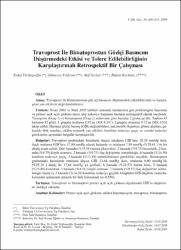Travoprost ile bimatoprostun göziçi basıncını düşürmedeki etkisi ve tolere edilebilirliğinin karşılaştırmalı retrospektif bir çalışması.
Künye
Yuzbaşioglu E, Yildirim H, Seylan A, Korkmaz B. [A comperative retrospective study of travoprost and bimatoprost in lowering effect of intraocular pressure and it's tolerability]. Turk J Ophthalmol 2009; 39(6): 425-429Özet
Amaç: Travoprost ile bimatoprostun göz içi basıncını düşürmedeki etkinliklerinin ve karşılaşılan yan etkilerin değerlendirilmesi.
Yöntem: Nisan 2002 ve Mart 2005 tarihleri arasında hastanemiz göz polikliniğine başvuran ve primer açık açılı glokom tanısı alıp tedaviye başlanan hastalar retrospektif olarak incelendi. Travoprost (Grup 1) ve bimatoprost (Grup 2) tedavisine göre hastalar 2 gruba ayrıldı. Toplam 45 hastanın 83 gözü, 1. grupda ortalama 8.92 ay (SD: 4.347), 2.grupda ortalama 9.72 ay (SD: 4.91) takip edildi. Hastalar göziçi basınç (GİB) değişiklikleri, pakimetrik ölçümler, görme alanları, çukurluk–disk oranları, oküler-sistemik yan etkileri, kombine tedaviye geçiş ve cerrahi tedaviye gereksinim açısından bulgular karşılaştırıldı.
Bulgular: Travoprost grubundaki hastaların ilaçsız ortalama GİB’ları; 25.29 mmHg iken, ilaçlı ortalama GİB’ları; 17.80 mmHg olarak bulundu ve ortalama 7.49 mmHg (%29.61 ) lık bir düşüş tespit edildi. Dört hastada (%19.51) batma şikayetleri, 2 hastada (%9.75) kızarıklık, 2 hastada (%9.75) kirpik uzaması, 2 hastada (%9.75) ilaç değiştirme zorunluluğu, 6 hastada (%24.39) kombine tedaviye geçiş, 3 hastada (%12.19) trabekülektomi gerekliliği duyuldu. Bimatoprost grubundaki hastalarda ortalama ilaçsız GİB 23.64 mmHg iken, ortalama 6.00 mmHg’lik (%25.38 ) düşüş ile 17.64 mmHg ya geriledi. 6 hastada (%28.57) batma hissi, 5 hastada (%23.80) kızarıklık, 1 hastada (%4.76) kirpik uzaması, 2 hastada (%9.52) ilaç değiştirme zorunluluğu oluştu ve 3 hastada (%14.28) kombine tedaviye geçildi. Grupların GİB düşürme oranı bakımından aralarında anlamlı bir fark bulunmadı (p=0.556).
Tartışma: Travoprost ve bimatoprost primer açık açılı glokom olgularında GİB’nı düşürmede oldukça etkilidir. Purpose: To determine the intraocular pressure–lowering efficacy and adverse effects of travoprost and bimatoprost.
Methods: Patients who were newly diagnosed as POAG at the outpatient department of our clinic between April 2002 and March 2005 and received topical anti-glaucoma medical therapy, were enrolled in this retrospective study. The cases were divided into two treatment groups for administration of travoprost(Group 1) and bimatoprost(Group 2). Eightythree eyes of 45 patients were followed up for 8.92(SD: 4.347) months in group 1 and 9.72(SD: 4.91) months in ngroup 2. Intraocular pressure changes, cup-to-disc ratios, visual field findings, central corneal pachymetry, ocular and systemic adverse effects, need for combination therapy and need for surgical therapy were followed and all of the findings were compared.
Results: The mean pre-treatment IOP of group 1 was 25.29 mmHg while the mean post-treatment IOP was 17.80 mmHg and the mean decrease in IOP of 7.49 mmHg(29.61% ). In group 1, the most common ocular side effects were foreign body sensation in 4 patients(19.51%), ocular hyperemia in 2 patients (%9.75) and eyelash lengthening in 2 patients (%9.75). We switched the medical therapy in 2 patients (%9.75), started combined medical therapy in 6 patients(%24.39) and performed trabeculectomy in 3 patients(%12.19). In bimatoprost group(group 2) the mean pre-treatment IOP was 23.64 mmHg while the mean post-treatment IOP was 17.64 mmHg and the mean decrease in IOP was 6.00 mmHg (%25.38). In group 2 the most common ocular side effects were foreign body sensation in 6 patients (%28.57), ocular hyperemia in 5 patients (%23.80) and eyelash lengthening in 1 patient (%4.76). We switched the medical therapy in 2 patients (%9.52) and started combined medical therapy in 3 patients (%14.28). There was no statistical difference between two groups in IOP lowering effect (p=0.556).
Conclusion: Both travoprost and bimatoprost are effective choice choices in reducing IOP in patients with POAG.


















